Spyros Chatzivasileiadis
Scalable Exact Verification of Optimization Proxies for Large-Scale Optimal Power Flow
May 09, 2024



Abstract:Optimal Power Flow (OPF) is a valuable tool for power system operators, but it is a difficult problem to solve for large systems. Machine Learning (ML) algorithms, especially Neural Networks-based (NN) optimization proxies, have emerged as a promising new tool for solving OPF, by estimating the OPF solution much faster than traditional methods. However, these ML algorithms act as black boxes, and it is hard to assess their worst-case performance across the entire range of possible inputs than an OPF can have. Previous work has proposed a mixed-integer programming-based methodology to quantify the worst-case violations caused by a NN trained to estimate the OPF solution, throughout the entire input domain. This approach, however, does not scale well to large power systems and more complex NN models. This paper addresses these issues by proposing a scalable algorithm to compute worst-case violations of NN proxies used for approximating large power systems within a reasonable time limit. This will help build trust in ML models to be deployed in large industry-scale power grids.
Correctness Verification of Neural Networks Approximating Differential Equations
Feb 12, 2024


Abstract:Verification of Neural Networks (NNs) that approximate the solution of Partial Differential Equations (PDEs) is a major milestone towards enhancing their trustworthiness and accelerating their deployment, especially for safety-critical systems. If successful, such NNs can become integral parts of simulation software tools which can accelerate the simulation of complex dynamic systems more than 100 times. However, the verification of these functions poses major challenges; it is not straightforward how to efficiently bound them or how to represent the derivative of the NN. This work addresses both these problems. First, we define the NN derivative as a finite difference approximation. Then, we formulate the PDE residual bounding problem alongside the Initial Value Problem's error propagation. Finally, for the first time, we tackle the problem of bounding an NN function without a priori knowledge of the output domain. For this, we build a parallel branching algorithm that combines the incomplete CROWN solver and Gradient Attack for termination and domain rejection conditions. We demonstrate the strengths and weaknesses of the proposed framework, and we suggest further work to enhance its efficiency.
Error estimation for physics-informed neural networks with implicit Runge-Kutta methods
Jan 10, 2024Abstract:The ability to accurately approximate trajectories of dynamical systems enables their analysis, prediction, and control. Neural network (NN)-based approximations have attracted significant interest due to fast evaluation with good accuracy over long integration time steps. In contrast to established numerical approximation schemes such as Runge-Kutta methods, the estimation of the error of the NN-based approximations proves to be difficult. In this work, we propose to use the NN's predictions in a high-order implicit Runge-Kutta (IRK) method. The residuals in the implicit system of equations can be related to the NN's prediction error, hence, we can provide an error estimate at several points along a trajectory. We find that this error estimate highly correlates with the NN's prediction error and that increasing the order of the IRK method improves this estimate. We demonstrate this estimation methodology for Physics-Informed Neural Network (PINNs) on the logistic equation as an illustrative example and then apply it to a four-state electric generator model that is regularly used in power system modelling.
GPU-Accelerated Verification of Machine Learning Models for Power Systems
Jun 18, 2023

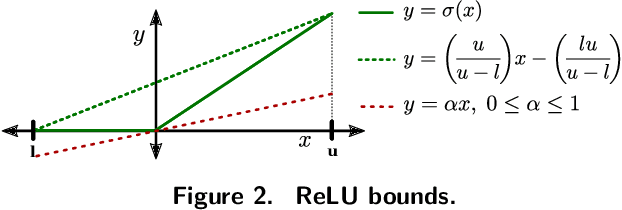

Abstract:Computational tools for rigorously verifying the performance of large-scale machine learning (ML) models have progressed significantly in recent years. The most successful solvers employ highly specialized, GPU-accelerated branch and bound routines. Such tools are crucial for the successful deployment of machine learning applications in safety-critical systems, such as power systems. Despite their successes, however, barriers prevent out-of-the-box application of these routines to power system problems. This paper addresses this issue in two key ways. First, for the first time to our knowledge, we enable the simultaneous verification of multiple verification problems (e.g., checking for the violation of all line flow constraints simultaneously and not by solving individual verification problems). For that, we introduce an exact transformation that converts the "worst-case" violation across a set of potential violations to a series of ReLU-based layers that augment the original neural network. This allows verifiers to interpret them directly. Second, power system ML models often must be verified to satisfy power flow constraints. We propose a dualization procedure which encodes linear equality and inequality constraints directly into the verification problem; and in a manner which is mathematically consistent with the specialized verification tools. To demonstrate these innovations, we verify problems associated with data-driven security constrained DC-OPF solvers. We build and test our first set of innovations using the $\alpha,\beta$-CROWN solver, and we benchmark against Gurobi 10.0. Our contributions achieve a speedup that can exceed 100x and allow higher degrees of verification flexibility.
Enriching Neural Network Training Dataset to Improve Worst-Case Performance Guarantees
Mar 23, 2023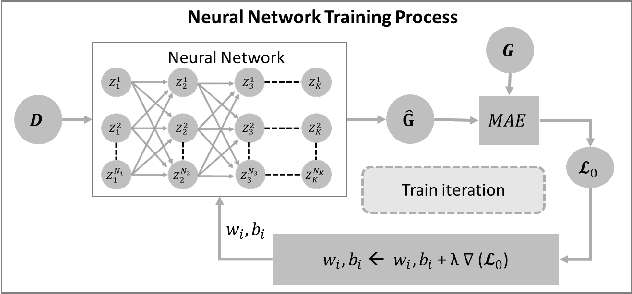
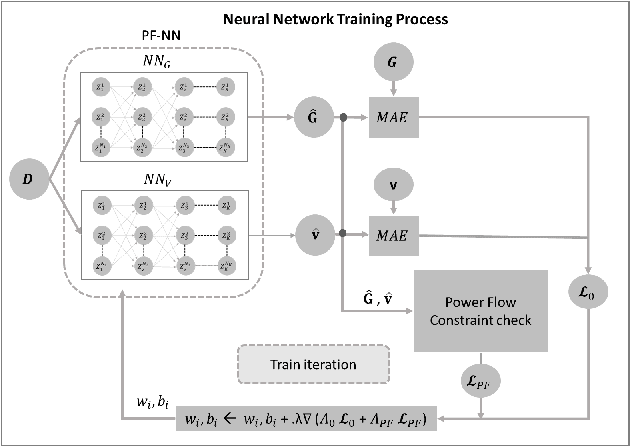
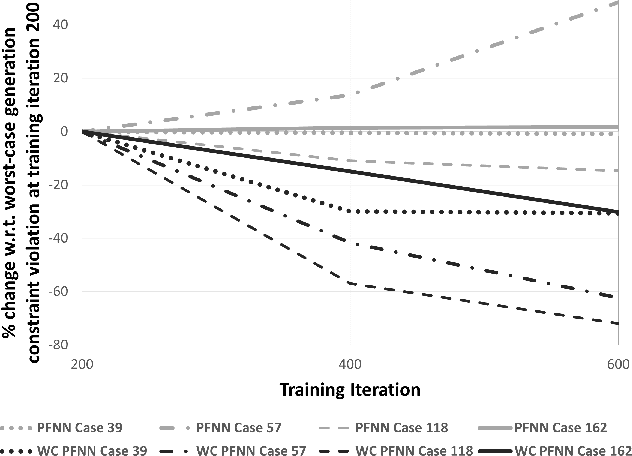

Abstract:Machine learning algorithms, especially Neural Networks (NNs), are a valuable tool used to approximate non-linear relationships, like the AC-Optimal Power Flow (AC-OPF), with considerable accuracy -- and achieving a speedup of several orders of magnitude when deployed for use. Often in power systems literature, the NNs are trained with a fixed dataset generated prior to the training process. In this paper, we show that adapting the NN training dataset during training can improve the NN performance and substantially reduce its worst-case violations. This paper proposes an algorithm that identifies and enriches the training dataset with critical datapoints that reduce the worst-case violations and deliver a neural network with improved worst-case performance guarantees. We demonstrate the performance of our algorithm in four test power systems, ranging from 39-buses to 162-buses.
Physics Informed Neural Networks for Phase Locked Loop Transient Stability Assessment
Mar 21, 2023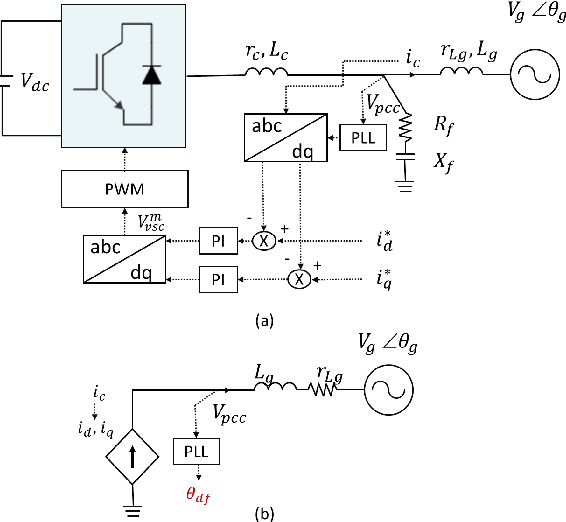

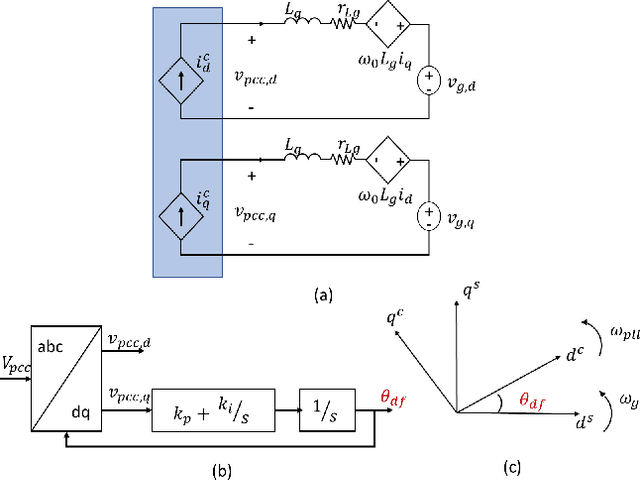
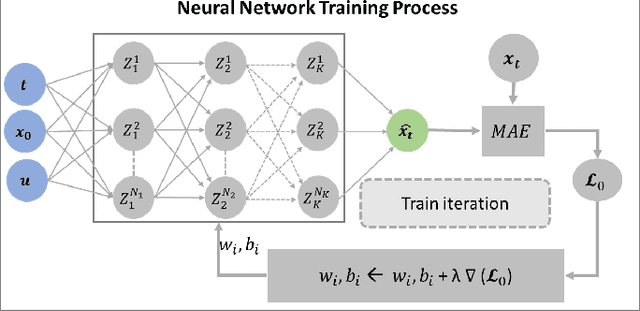
Abstract:A significant increase in renewable energy production is necessary to achieve the UN's net-zero emission targets for 2050. Using power-electronic controllers, such as Phase Locked Loops (PLLs), to keep grid-tied renewable resources in synchronism with the grid can cause fast transient behavior during grid faults leading to instability. However, assessing all the probable scenarios is impractical, so determining the stability boundary or region of attraction (ROA) is necessary. However, using EMT simulations or Reduced-order models (ROMs) to accurately determine the ROA is computationally expensive. Alternatively, Machine Learning (ML) models have been proposed as an efficient method to predict stability. However, traditional ML algorithms require large amounts of labeled data for training, which is computationally expensive. This paper proposes a Physics-Informed Neural Network (PINN) architecture that accurately predicts the nonlinear transient dynamics of a PLL controller under fault with less labeled training data. The proposed PINN algorithm can be incorporated into conventional simulations, accelerating EMT simulations or ROMs by over 100 times. The PINN algorithm's performance is compared against a ROM and an EMT simulation in PSCAD for the CIGRE benchmark model C4.49, demonstrating its ability to accurately approximate trajectories and ROAs of a PLL controller under varying grid impedance.
Solving Differential-Algebraic Equations in Power Systems Dynamics with Neural Networks and Spatial Decomposition
Mar 17, 2023



Abstract:The dynamics of the power system are described by a system of differential-algebraic equations. Time-domain simulations are used to understand the evolution of the system dynamics. These simulations can be computationally expensive due to the stiffness of the system which requires the use of finely discretized time-steps. By increasing the allowable time-step size, we aim to accelerate such simulations. In this paper, we use the observation that even though the individual components are described using both algebraic and differential equations, their coupling only involves algebraic equations. Following this observation, we use Neural Networks (NNs) to approximate the components' state evolution, leading to fast, accurate, and numerically stable approximators, which enable larger time-steps. To account for effects of the network on the components and vice-versa, the NNs take the temporal evolution of the coupling algebraic variables as an input for their prediction. We initially estimate this temporal evolution and then update it in an iterative fashion using the Newton-Raphson algorithm. The involved Jacobian matrix is calculated with Automatic Differentiation and its size depends only on the network size but not on the component dynamics. We demonstrate this NN-based simulator on the IEEE 9-bus test case with 3 generators.
Physics-Informed Neural Networks for Time-Domain Simulations: Accuracy, Computational Cost, and Flexibility
Mar 15, 2023Abstract:The simulation of power system dynamics poses a computationally expensive task. Considering the growing uncertainty of generation and demand patterns, thousands of scenarios need to be continuously assessed to ensure the safety of power systems. Physics-Informed Neural Networks (PINNs) have recently emerged as a promising solution for drastically accelerating computations of non-linear dynamical systems. This work investigates the applicability of these methods for power system dynamics, focusing on the dynamic response to load disturbances. Comparing the prediction of PINNs to the solution of conventional solvers, we find that PINNs can be 10 to 1000 times faster than conventional solvers. At the same time, we find them to be sufficiently accurate and numerically stable even for large time steps. To facilitate a deeper understanding, this paper also presents a new regularisation of Neural Network (NN) training by introducing a gradient-based term in the loss function. The resulting NNs, which we call dtNNs, help us deliver a comprehensive analysis about the strengths and weaknesses of the NN based approaches, how incorporating knowledge of the underlying physics affects NN performance, and how this compares with conventional solvers for power system dynamics.
Scalable Optimal Design of Incremental Volt/VAR Control using Deep Neural Networks
Jan 04, 2023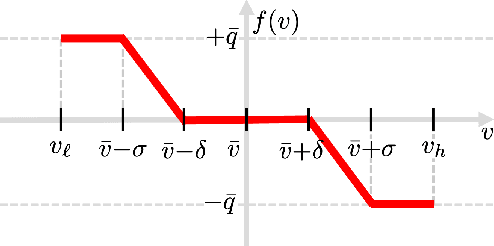
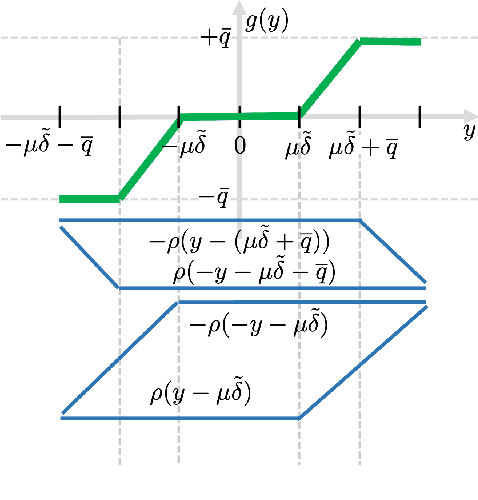
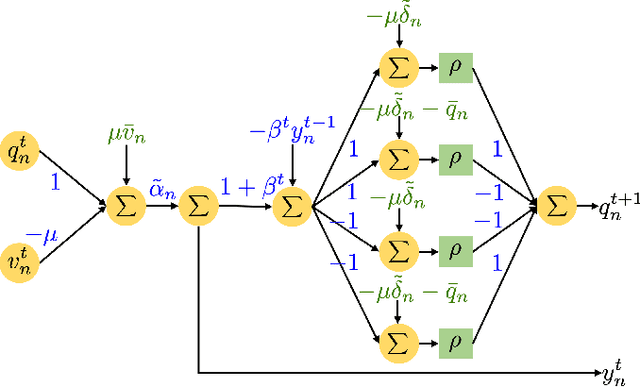
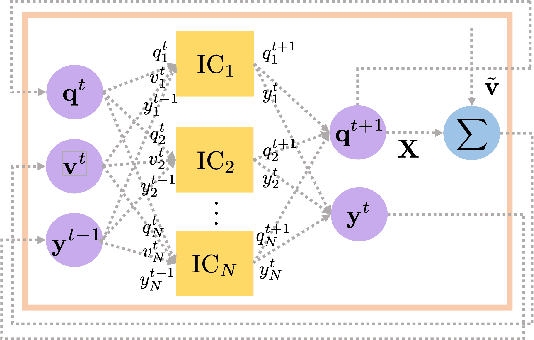
Abstract:Volt/VAR control rules facilitate the autonomous operation of distributed energy resources (DER) to regulate voltage in power distribution grids. According to non-incremental control rules, such as the one mandated by the IEEE Standard 1547, the reactive power setpoint of each DER is computed as a piecewise-linear curve of the local voltage. However, the slopes of such curves are upper-bounded to ensure stability. On the other hand, incremental rules add a memory term into the setpoint update, rendering them universally stable. They can thus attain enhanced steady-state voltage profiles. Optimal rule design (ORD) for incremental rules can be formulated as a bilevel program. We put forth a scalable solution by reformulating ORD as training a deep neural network (DNN). This DNN emulates the Volt/VAR dynamics for incremental rules derived as iterations of proximal gradient descent (PGD). Analytical findings and numerical tests corroborate that the proposed ORD solution can be neatly adapted to single/multi-phase feeders.
Minimizing Worst-Case Violations of Neural Networks
Dec 21, 2022Abstract:Machine learning (ML) algorithms are remarkably good at approximating complex non-linear relationships. Most ML training processes, however, are designed to deliver ML tools with good average performance, but do not offer any guarantees about their worst-case estimation error. For safety-critical systems such as power systems, this places a major barrier for their adoption. So far, approaches could determine the worst-case violations of only trained ML algorithms. To the best of our knowledge, this is the first paper to introduce a neural network training procedure designed to achieve both a good average performance and minimum worst-case violations. Using the Optimal Power Flow (OPF) problem as a guiding application, our approach (i) introduces a framework that reduces the worst-case generation constraint violations during training, incorporating them as a differentiable optimization layer; and (ii) presents a neural network sequential learning architecture to significantly accelerate it. We demonstrate the proposed architecture on four different test systems ranging from 39 buses to 162 buses, for both AC-OPF and DC-OPF applications.
 Add to Chrome
Add to Chrome Add to Firefox
Add to Firefox Add to Edge
Add to Edge